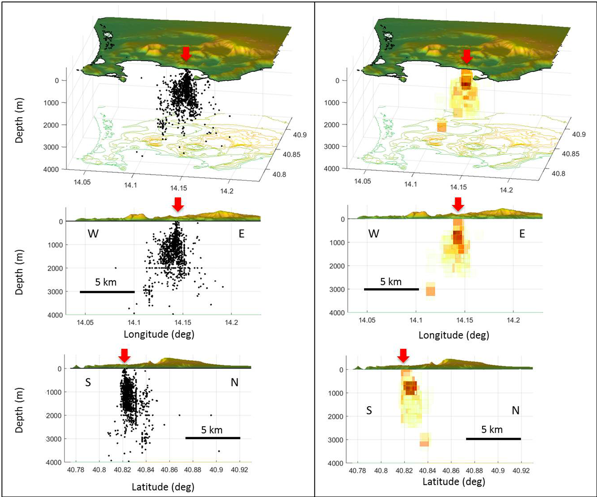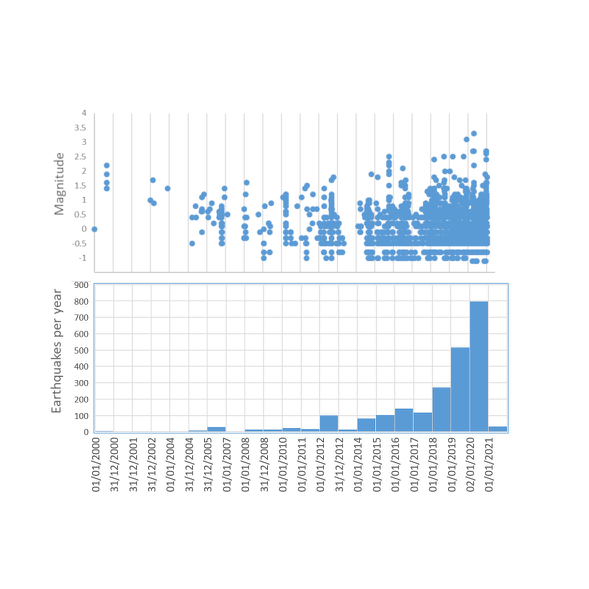Plot of the earthquake magnitudes with time, top, and histogram of the earthquakes per year, bottom.
Seismicity at Campi Flegrei since 2000 and updated to 2020. Left column: location of the earthquakes recorded in the Campi Flegrei since 2000. Right column: hypocenter densities on a 200-m-spaced grid cells. The minimum value is two earthquakes per cell; the maximum is 10 earthquakes per cell. The red arrow indicates the position of the Pisciarelli hydrothermal area. The plots have a vertical exaggeration of 2.
In this WP, we will focus on the analysis of the seismic signals recorded in the Campi Flegrei by INGV-OV seismic network from 2012 to 2019 to highlight any eventual variation and explore its meaning. We plan to analyze the seismic noise recorded in the caldera focusing on its characteristics and variations in time (task 3.1); to statistically analyze the seismic catalogue with the aim to evidence the seismicity characteristics in time and space (task 3.2) and to analyze the seismic fumarolic tremor recorded close to Pisciarelli hydrothermal area to delineate its source mechanism and to verify its possible meaning as indicator of unrest. Finally, we will interpret the achieved results with geochemical, and geodetic data and the OV seismic catalogue to define the best conceptual model supporting all gathered observations.
Task 3.1) Noise-cross correlation for seismic velocity variations.
In this task we plan to apply the noise cross correlation techniques to seismic data recorded by INGV-OV seismic network from 2012 to 2019 at the Campi Flegrei caldera to evidence any velocity changes of the medium with time and to eventually associate them to other geodetical, geochemical and seismological changes.
Despite the seismic studies performed in the last decades using the data of the last bradiseismic crises and/or active experiments executed in 2001 (Zollo et al., 2008), a high detailed image of the shallow portion of the caldera is actually not available and, anyway, not updated. Particularly, noise correlation techniques applied at Campi Flegrei between 2011 and 2015 allowed to identify little velocity changes of the rocky substrate possibly linked to changes in magma/fluid dynamic, as also evidenced by coherent changes of other geochemical or geodetic parameters (Zaccarelli and Bianco, 2017). Part of these data, collected between 2011 and 2013, have been also used to reconstruct the shear wave velocity model but without
analyzing any temporal variation of them (De Siena et al., 2018).
Task 3.2) Statistical analyses of seismic cataloge.
In this task we will perform a statistical analysis of the seismic catalogue of Campi Flegrei. In particular, we will analyze changes with time and space of recurrence rate of local earthquakes. INGV-OV seismic catalogue shows, indeed, an evident increase of seismic rate from 2016 until today passing from ~ 300 to ~ 800 events per year. Moreover, using the same catalogue, a detailed analysis of the most energetic swarms recorded since 2000 will be performed to help in identifying the faults that are more productive and to correlate them to the outgassing dynamics. The identification of doublets within the earthquakes recorded since 2000 would eventually allow to evidence long term variations in the medium properties, in parallel to the analysis performed with the noise cross correlation (task 3.1).
Task 3.3) Investigating fumarolic tremor source dynamics at Campi Flegrei caldera.
In this task we propose to investigate fumarolic tremor at Campi Flegrei Caldera using data from INGV permanent seismic network and using ad-hoc temporary deployments of seismic arrays. Campi Flegrei Caldera is, indeed, characterized by a high-frequency tremor source generated by fumarole outgassing. During 2012 and 2013 Campi Flegrei caldera experienced a phase of increase in the uplift rate (De Martino et al., 2014, Chiodini et al., 2015; Tamburello et al., 2019), which was followed by increases of shallow earthquake occurrence rate and also by a significant increase of fumarolic tremor amplitude (Giudicepietro et al., 2019). The aim of this task is to characterize tremor source mechanism and its variation through time and space within the last decade in order to improve our understanding of the magma plumbing system and associated degassing dynamics. The results will also improve our ability to detect any volcanic tremor precursors associated with the next eruption, with strong implications on risk management of Neapolitan urbanized area.


